Serviços Personalizados
Artigo
Links relacionados
Compartilhar
RSBO (Online)
versão On-line ISSN 1984-5685
RSBO (Online) vol.12 no.1 Joinville Jan./Mar. 2015
Original Research Article
Evaluation of graduate dental students' knowledge on the therapeutic approach of dental avulsion
Tiago André Fontoura de MeloI; Cíntia Muniz CoutoI
I Department of Dentistry, São Leopoldo Mandic/SP Post-Graduation Center, Porto Alegre unit – Porto Alegre – RS – Brazil
ABSTRACT
Introduction and Objetive : Introduction and Objective: The present study aimed to evaluate the knowledge level of students graduate in Dentistry of São Leopoldo Mandic/SP – Porto Alegre/RS on the therapeutic approach in cases of dental avulsion. Material and methods: For this, we applied a questionnaire to graduate students. Of the 214 students enrolled at the institution, 159 (74%) answered the questions. Results and Conclusion: Through analysis of the responses, it could be observed that, while 99.37% of participants have already received instructions about the subject, there was significant variability of opinions. With the application of Chi-square test, at a significance level of 5%, it could be observed that there was no significant difference in responses regarding to the time of graduation. As for the type of splinting, the professionals who graduated between 5 to 10 years were associated with the use of semi-rigid splint and those who graduate after more than 10 years with the rigid splint.
Keywords: tooth avulsion; tooth replantation; health knowledge, attitudes, practice.
Introduction
Tooth avulsion is one of the dental situations of more complex, diagnosis, treatment and followup because the approach should always be well planned in the context of limiting the risk of infection in the root canal, minimizing the extent of the inflammation surrounding the region of the supporting tissue, and maintaining the aesthetic pattern of the patient.
Successful replantation is closely related to several factors, such as extra-alveolar time and the form of management of the avulsed tooth20. Thus, the treatment of avulsion, when performed in adverse conditions may result, over time, in tooth ankylosis, and inflammatory or replacement root resorption5,10.
Therefore, prior knowledge about an effective approach in accordance with proper care related to tooth replantation is a key factor.
Some studies have been conducted to assess the knowledge of parents or guardians14,22,25, professors2,18, Dentistry undergraduates13 and health professionals9,12 on the therapeutic approach of avulsed teeth.
França et al. 12 applied a questionnaire to 93 dentists in the city of Tubarão, and found that 36.6% of participants chose the answer considered correct for a situation of tooth avulsion of a 12 year old patient who took his tooth at the time of the appointment.
On the other hand, Díaz et al.9 conducted a survey on doctors and paramedics in Chile, through the application of a questionnaire, and found that, of the 82 participants, 43.9% claimed that they do not replanted an avulsed tooth because the dentist is responsible for this procedure and only 9.8% answered correctly on storage methods.
In 2010, Zhao and Gong31 evaluated the knowledge on the treatment of avulsion of 274 dentists from 15 hospitals in Beijing (China), and concluded that there is no consensus on the storage medium, dental splinting technique and type of intracanal medication used.
Because of the variety of responses observed in different studies and because the dentist is the professional technically qualified for the treatment of this type of injury, this study aimed to evaluate the level of knowledge of dental graduates from São Leopoldo Mandic (SP) Post-Graduation Center – Porto Alegre (RS) unit on the therapeutic approach in cases of tooth avulsion.
Material and methods
A quantitative research was conducted through an objective questionnaire on the students enrolled in the Dentistry Post-Graduation Program, lato sensu, of São Leopoldo Mandic (SP) Post-Graduation Center – Porto Alegre (RS) unit, in October 2012.
The students part icipat ing in the study were enrolled in the specialization courses in Endodontics, Prosthodontics, Implant Dentistry, Orthodontics and Radiology.
Initially, the students were informed on the study objectives to let them know the importance and the relevance of their responses to the questionnaire to assess the knowledge of dentists on how to approach in cases of tooth avulsion.
The questionnaire (Figure 1 and 2). was applied to all students voluntarily. It was assured the participants that their identity would be kept secret. All respondents signed a free and clarified consent form before answering the questionnaire. (Figure 1).

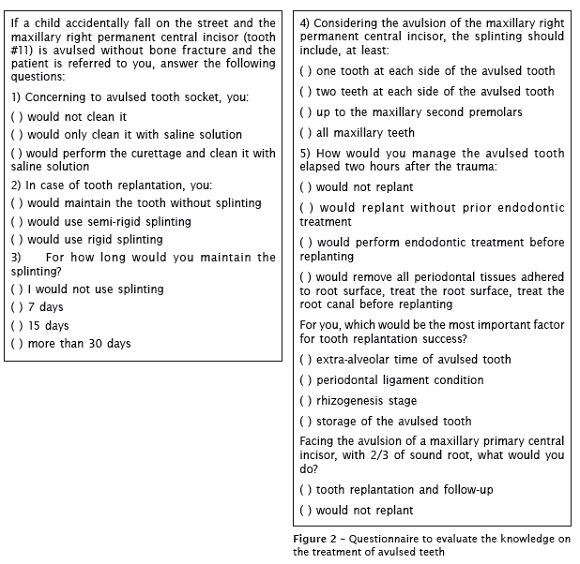
The students were asked to mark only one answer per question, not being allowed to consult the scientific literature on the subject.
After collection, the data were tabulated and verified statistically by using the Chi-square test at a significance level of 5%.
Results
Of 214 dental graduates enrolled in São Leopoldo Mandic (SP) Post-Graduation Center – Porto Alegre (RS) unit, 159 graduates participated in this present study (74%).
Table I shows the graduates' distribution according to the graduation time, specialty and level of previous knowledge on tooth avulsion.

Concerning to tooth avulsion approach and treatment, the results are seen in figures 3 to 9.
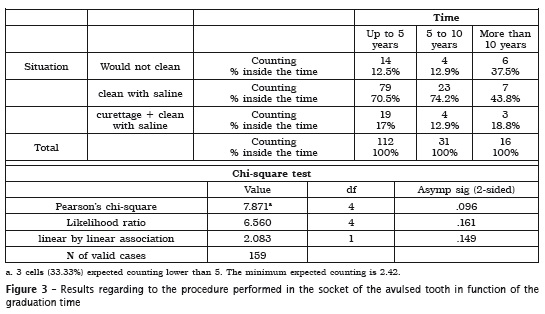
Through Chi-square test, with p = 0.096, it was verified no association between the graduation time and the response on the procedure carried out in the socket of the avulsed tooth.
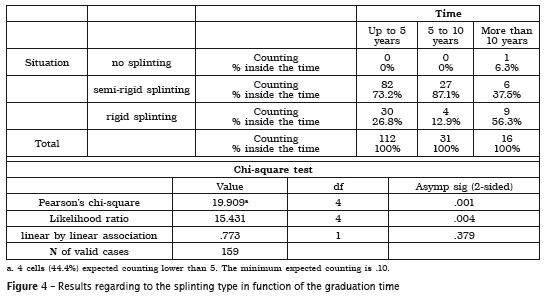
Through Chi-square test, complemented by the Analysis Of Adjusted Residuals, at level of significance of 5%, it was verified that the professional who graduated from 5 to 10 years were locally associated with the use of semi-rigid splinting and those who graduated from more than 10 years with rigid splinting.
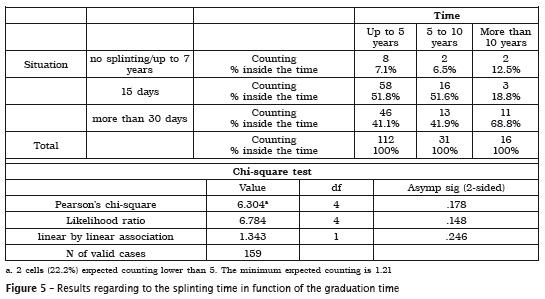
Through Chi-square test, with p = 0.178, no association was verified between the graduation time and the response on the splinting time. Through Chi-square test, with p = 0,422, no association was verified between the graduation time and the splinting extension.
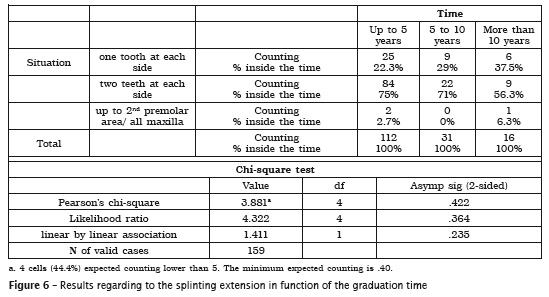
Through Chi-square test, with p = 0,422, no association was verified between the graduation time and the splinting extension.
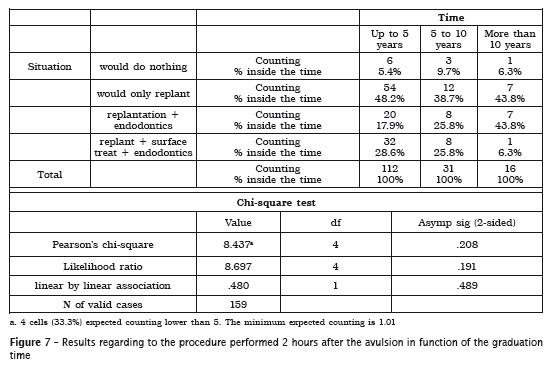
Through Chi-square test, with p = 0.208, no association was verified between the graduation time and the response on the procedure performed 2 hours after the avulsion.
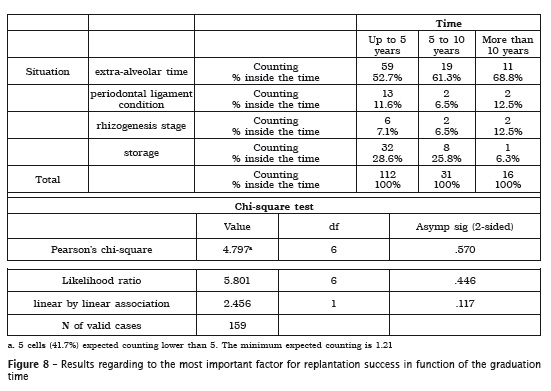
Through Chi-square test, with p = 0.570, no association was seen between the graduation time and the response on the most important factor for replantation success.
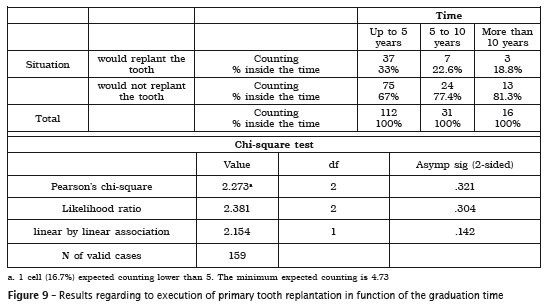
Through Chi-square test, with p = 0.321, no association was verified between the graduation time and the response on the primary tooth replantation.
Discussion
The care provided immediately or the first care attitudes to the patient injured with dentoalveolar trauma, especially in cases of avulsed teeth, can decide either the success or failure in clinical prognosis24. Therefore, it is necessary that the population and health professionals are better informed on the emergency care for these types of injuries.
Thus, this study was conducted with a group of graduate students in dentistry in order to verify the knowledge on avulsion treatment, similarly to the studies of Kostopoulou and Duggal16, França et al.12, Westphalen et al.29, Vasconcellos et al.28, and Zhao and Gong31, who also applied a questionnaire to dentists.
The definition of the target group was based on the fact that the dentists educate and make the population aware about this subject.
Although 81.13% of the participants never treated an avulsion case, – as observed in the study of Pacheco et al. 23 in which 88.3% of the professors never treated tooth avulsion and Mori et al.21 with 77% –, of the 159 graduates answering the questionnaire, 99.37% reported they had already received instruction on tooth avulsion, corroborating the studies of Díaz et al.9 and Krastl et al.17.
Concerning to the treatment of the socket of the avulsed tooth, most of the respondents only would clean it with saline solution. This information was also observed in the study of Vasconcellos et al.28, in which 64.1% of the dentists would also clean the tooth socket.
With regard to the splinting type, although without statistically significance in relation to the graduation time, most of the dentists would execute the semi-rigid splinting, similarly to the studies of Westphalen et al.29 (73%) and Vasconcellos et al.28 (82.2%). On the other hand, in the study of Zhao and Gong31, of the 258 dentists, 49% would use rigid and 45.1% semi-rigid splinting.
According to Diangelis and Bakland 8, Flores et al.11 and Trope27, semi-rigid splinting favors pulp and periodontal healing and stabilizes the tooth during the healing period, providing the regeneration of the periodontal ligament, consequently reducing the chances for ankylosis and resorption.
In this present study, no difference was seen between splinting time for 15 and 30 days. This was also verified by the studies of Kostoupoulou and Duggal16, Westphalen et al.29,and Vasconcellos et al.28.
According to Andreasen and Andreasen4, a period of one week is enough to assure a proper periodontal support because the gingival fibers would be already repaired within this time interval.
Concerning to the most important factor for replantation success, most of the students identified the extra-alveolar time, similarly to the study of Zhao and Gong31, in which 78.8% of the dentists considered the time factor as mandatory for the success of avulsion cases.
The survival of the periodontal ligament present on the root surface is related to short extra-alveolar period and several studies6,15,30 have reported this as the most important factor for replantation success. When the tooth is not replanted at the time of avulsion, the patient should be instructed to store it in appropriate media and search a dentist as soon as possible. The storage, according to Trope27, aims at minimizing the post-replantation inflammatory response because it avoids dryness and keeps the periodontal ligament cell viability for longer time.
In the case of avulsed teeth with complete root formation that remained in dry medium for more than 2 hours, the treatment of choice consists in removing the periodontal ligament of the tooth, treating the root surface, performing the endodontics prior to replantation26,27.
With regard to the replantation of primary teeth, the vast majority of dentists would not replanted the tooth in its socket, which agrees with the data obtained in the studies of Cohenca et al.7 (85.3%), Al-Asfour et al.1 (71%), and Zhao and Gong31 (87.1%).
According to the American Academy of Pediatric Dentistry3, the replantation of avulsed primary teeth is contraindicated due to possible consequences for the development of the permanent tooth.
Conclusion
Based on the results obtained, it could be verified a variability of opinion on the subject. It is important to highlight that although 99.37% of the participants had already been instructed on the treatment of avulsed teeth during graduation, their knowledge could be improved regardless of the graduation time.
References
1. Al-Asfour A, Andersson L, Al-Jame Q. School teachers' knowledge of tooth avulsion and dental first aid before and after receiving information about avulsed teeth and replantation. Dent Traumatol. 2008 Feb;24(1):43-9. [ Links ]
2. Al-Obaida M. Knowledge and management of traumatic dental injuries in a group of Saudi primary schools teachers. Dent Traumatol. 2010 Aug;26(4):338-41.
3. American Academy of Pediatric Dentistry. Clinical guideline on management of acute dental trauma. Manual de referência – ano 2004/2005.
4. Andreasen JO, Andreasen FM. Texto e atlas colorido de traumatismo dental. 3. ed. Porto Alegre: Artmed; 2001.
5. Andreasen JO, Lauridsen E, Gerds TA, Ahrensburg SS. Dental trauma guide: a source of evidence-based treatment guidelines for dental trauma. Dent Traumatol. 2012 Oct;28(5): 345-50.
6. Boyd DH, Kinirons MJ, Gregg TA. A prospective study of factors affecting survival of replanted permanent incisors in children. Int J Pediatric Dent. 2000 Sep;10(3):200-5.
7. Cohenca N, Forrest JL, Rotstein I. Knowledge of oral health professionals of treatment of avulsed teeth. Dent Traumatol. 2006 Dec;22(6):296-301.
8. Diangelis AJ, Bakland LK. Traumatic dental injuries: current treatment concepts. J Am Dent Assoc. 1998 Oct;129(10):1401-14.
9. Díaz J, Bustos L, Herrera S, Sepulveda J. Knowledge of the management of paediatric dental traumas by non-dental professionals in emergency rooms in South Araucania, Temuco, Chile. Dent Traumatol. 2009 Dec;25(6):611-9.
10. Fernandes AV. Programa "Salve um dente": r e implant e dentár io. Re v CROMG. 1995 Fev;1(1):37-9.
11. Flores MT, Andreasen JO, Bakland LK, Feiglin B, Gutmann JL, Oikarinen K et al. Guidelines for the evaluation and management of traumatic dental injuries. Dent Traumatol. 2001 Apr;17(2):49-52.
12. França RI, Traebert J, Lacerda JT. Brazilian dentists' knowledge regarding immediate treatment of traumatic dental injuries. Dent Traumatol. 2007 Oct;23(5):287-90.
13. Fujita Y, Shiono Y, Maki K. Knowledge of emergency management of avulsed tooth among Japanese dental students. BMC Oral Health. 2014 Apr 8;14(1):34.
14. Ghaderi F, Adl A, Ranjbar Z. Effect of a leaflet given to parents on knowledge of tooth avulsion. Eur J Paediatr Dent. 2013 Mar;14(1):13-6.
15. Kenny DJ, Barrett EJ, Casas MJ. Avulsions and intrusions: the controversial displacement injuries. J Can Dent Assoc. 2003 May;69(5):308-13.
16. Kostopoulou MN, Duggal MS. A study into dentists' knowledge of the treatment of traumatic injuries to young permanent incisors. Int J Paediatr Dent. 2005 Jan;15(1):10-9.
17. Krastl G, Fillipi A, Weiger R. German general dentists' knowledge of dental trauma. Dent Traumatol. 2009 Feb;25(1):88-91.
18. Lieger O, Graf C, El-Maaytah M, Von Arx T. Impact of educational posters on the lay knowledge of school teachers regarding emergency management of dental injuries. Dent Traumatol. 2009 Aug;25(4):406-12.
19. Mesgarzadeh AH, Shahamfar M, Hefzollesan A. Evaluat ing knowledge and at t i tudes of elementary school teachers on emergency management of traumatic dental injuries: a study in an Iranian urban area. Oral Health Prev Dent. 2009;7(3):297-308.
20. Miranda ACE, Habitante SM, Candelária LFA. Revisão de determinados fatores que influenciam no sucesso do reimplante dental. Rev Biociênc Unitau. 2000 Jan/Jul;6(1):35-9.
21. Mori GG, Castilho LR, Nunes DC, Turcio KH, Molina RO. Avulsion of permanent teeth: analysis of the efficacy of an informative campaign for professionals from elementary schools. J Appl Oral Sci. 2007 Dec;15(6):534-8.
22. Oliveira TM, Sakai VT, Moretti AB, Silva TC, Santos CF, Machado MA. Knowledge and attitude of mothers with regards to emergy management of dental avulsion. J Dent Child. 2007 Sep- Dec;74(3):200-2.
23. Pacheco LF, Filho PF, Letra A, Menezes R, Villoria GE, Ferreira SM. Evaluation of the knowledge on the treatment of avulsions in elementary school teachers in Rio de Janeiro, Brazil. Dent Traumatol. 2003 Apr;19(2):76-8.
24. Pohl Y, Filippi A, Kirschner H. Results after replantation of avulsed permanent teeth. I. Endodontic considerations. Dent Traumatol. 2005 Apr;21(2):80-92.
25. Santos ME, Habecost AP, Gomes FV, Weber JB, Oliveira MG. Parent and caretaker knowledge about avulsion of permanent teeth. Dent Traumatol. 2009 Apr;25(2):203-8.
26. Trope M. Treatment of the avulsed tooth. Pediatric Dent. 2000 Mar-Apr;22(2):145-7.
27. Trope M. Clinical management of the avulsed tooth: present strategies and future directions. Dent Traumatol. 2002 Feb;18(1):1-11.
28. Vasconcellos LG, Brentel AS, Vanderlei AD, Vasconcellos LM, Valera MC, Araújo MA. Knowledge of general dentists in the current guidelines for emergency treatment of avulsed teeth and dental trauma prevention. Dent Traumatol. 2009 Dec;25(6):578-83.
29. Westphalen VP, Martins WD, Deonizio MD, Silva Neto UX, Cunha CB, Fariniuk LF. Knowledge of general practitioners dentists about the emergency management of dental avulsion in Curitiba, Brazil. Dent Traumatol. 2007 Feb;23(1):6-8.
30. Wong KS, Sae-Lim V. The effect of intracanal Ledermix on root resorpt ion of delayedreplanted monkey teeth. Dent Traumatol. 2002 Dec;18(6):309-15.
31. Zhao Y, Gong Y. Knowledge of emergency management of avulsed teeth: a survey of dentists in Beijing, China Dent Traumatol. 2010 Jun;26(3):281-4.
 Corresponding author:
Corresponding author:
Tiago André Fontoura de Melo
Rua Eça de Queiroz, n. 466, apartamento 701 – Petrópolis
CEP 90670-020 – Porto Alegre – RS – Brasil
E-mail: tafmelo@gmail.com
Received for publication: March 12, 2014
Accepted for publication: September 23, 2014













